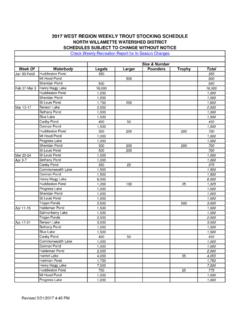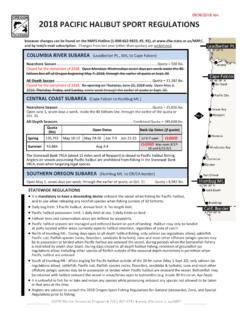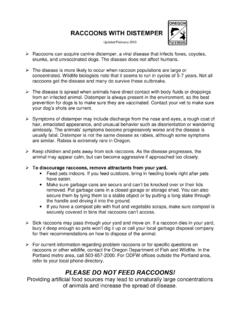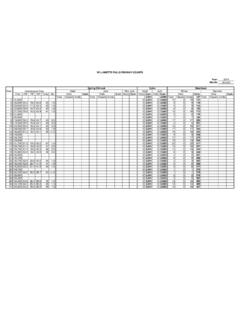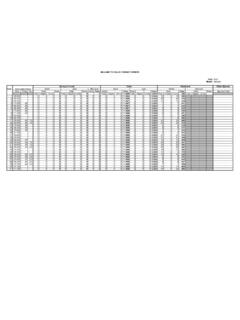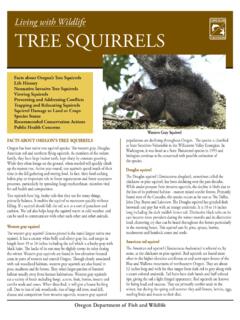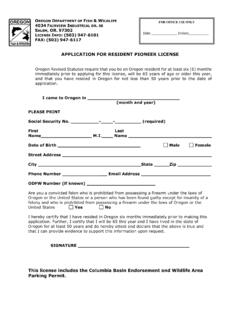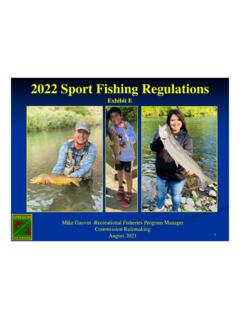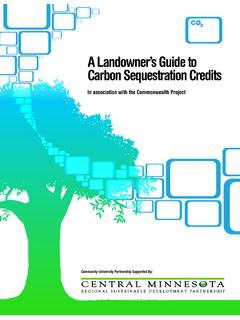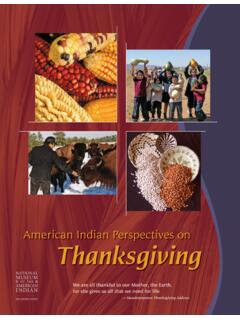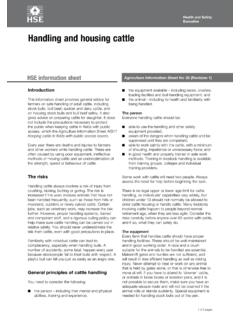Transcription of Field Guide to the Geese of the - dfw.state.or.us
1 Identification Field Guide to the Geese of the Willamette Valley and Lower Columbia River Second Edition Kelly Warren Wild Spirit Resources LLC Identification Field Guide to the Geese of the Willamette Valley and Lower Columbia River Second Edition Wild Spirit Resources LLC By Kelly Warren Copyright Wild Spirit Resources LLC. 2006 Identification Field Guide to the Geese of the Willamette Valley and Lower Columbia River, 2nd Edition 3 TABLE OF CONTENTS Table of Contents .. 3 Acknowledgments .. 5 Dedication: Dr. Charles Edward Warren .. 5 Photo and Illustration Credits.
2 5 1. 6 2. Identification Parameters .. 9 Hunters Tips .. 10 3. Cackling and Canada Goose Identification .. 11 Cackling Goose (Cackler) .. 11 Description .. 11 Distribution .. 20 History .. 21 21 Management .. 21 Future .. 22 Aleutian Goose (Aleutian) .. 23 Description .. 23 Distribution .. 25 26 Management .. 26 Future .. 26 Taverner s Goose (Taverner s) .. 27 Description .. 27 Distribution .. 33 34 Management .. 34 Future .. 34 Lesser Canada Goose (Lesser) .. 35 Description .. 35 Distribution .. 42 43 Management .. 43 Future .. 43 Dusky Canada Goose (Dusky) .. 44 Description.
3 44 Distribution .. 53 History .. 54 54 Management .. 55 Future .. 55 Vancouver Canada Goose .. 56 Description .. 56 Distribution .. 56 Behavior and Management .. 56 Western Canada Goose (Western, Honker or Great Basin) .. 57 Identification Field Guide to the Geese of the Willamette Valley and Lower Columbia River, 2nd Edition 4 Description .. 57 Distribution .. 63 History .. 63 64 Management .. 64 4. Other Goose Species in the Willamette Valley and Lower Columbia River .. 65 Greater White-Fronted Goose .. 65 Description .. 65 History .. 69 69 Future .. 69 Lesser Snow Goose .. 70 Description.
4 70 70 Management .. 70 Future .. 70 5. Comparing Goose Subspecies .. 72 6. Neck Collar Photos .. 79 Sources of Information and Photos .. 83 Identification Field Guide to the Geese of the Willamette Valley and Lower Columbia River, 2nd Edition 5 ACKNOWLEDGMENTS This Field Guide was prepared with support from the Oregon and Washington Departments of Fish and Wildlife (ODFW and WDFW) and the Baskett Slough, William L. Finley and Ankeny National Wildlife Refuge offices of the Fish and Wildlife Service (USFWS). Special thanks are given to Brad Bales (ODFW), Don Kraege (WDFW), Brandon Reishus (ODFW), Molly Monroe (USFWS), Dave Smith Decoys crew, Jay Llewellyn (USFWS), Deanna Emig (USFWS), Tom Rothe (Alaska Department of Fish and Game (ADFG)), Mike Petrula (ADFG) Dr.
5 Bob Jarvis, Worth Mathewson, Dan Warren, Bill Wilson, Pete Gutbrod and Terry Luther. Dedication: Dr. Charles Edward Warren This Guide is dedicated to my grandfather and friend Dr. Charles Edward Warren. From the beginning of his life till the end, he lived in the outdoors, hunting, fishing and taking care of nature and its splendor. He never left a job unfinished. He made a difference through his hundreds of students or anyone who had a chance to meet him. This is to the man who knew what was right in nature and the world. He was the one who taught me all that I know about nature. His character, exuberance, lessons, and passion for family, students and nature will never be forgotten.
6 Photo and Illustration Credits All photos and illustrations by Kelly Warren except: Figure 1 by Dan Portman, based on a map by Pacific Flyway Council Figures 45, 46 and 110 courtesy of Dave Smith Decoys Figures 22 courtesy of Fish and Wildlife Service Figure 62 courtesy of Bryan Stone Figure 107 courtesy of Evan Alcantara Figure 127 courtesy of Brad Cochran Identification Field Guide to the Geese of the Willamette Valley and Lower Columbia River, 2nd Edition 6 1. INTRODUCTION regon s Willamette Valley and the lower Columbia River region of both Oregon and Washington host seven subspecies of cackling and Canada Geese as well as other species of Geese : Cackling goose (Branta hutchinsii minima) Aleutian goose (B.)
7 Hutchinsii leucopareia) Taverner s goose (B. hutchinsii taverneri) Lesser Canada goose (B. canadensis parvipes) Dusky Canada goose (B. canadensis occidentalis) Vancouver Canada goose (B. canadensis fulva) Western Canada goose (B. canadensis moffitti) Greater white-fronted goose (Anser albifrons) Lesser snow goose (Chen caerulescens caerulescens) For clarity and simplicity, this Field Guide generally references common names for the goose subspecies rather than their official species and subspecies designations. The Willamette Valley and lower Columbia River are included in a special management zone (Figure 1) created in 1986 by the Oregon Department of Fish and Wildlife (ODFW), the Washington Department of Fish and Wildlife (WDFW), the Pacific Flyway Council, and the Fish and Wildlife Service (USFWS), primarily to protect the dusky Canada goose (dusky), whose population had declined significantly from historical O Figure 1: Winter use areas of dusky Canada Geese .
8 Identification Field Guide to the Geese of the Willamette Valley and Lower Columbia River, 2nd Edition 7 levels. In this Field Guide , this special management zone is referred to as the Permit Zone. At the time of creation of the Permit Zone, the Taverner s and lesser goose, as well as other Canada goose populations, were becoming more numerous in the region. Regulations exist to minimize the harvest of duskys while supporting harvest of more abundant Geese . Some legal Geese , however, are easily confused in the Field with the dusky. Hunters are required to take an examination to test their ability to identify the various goose species and subspecies before receiving a permit to hunt within the Permit Zone.
9 Only hunters who successfully pass the examination with a score of at least 80% will receive a permit to hunt Geese in the Permit Zone. farmers , waterfowl hunters, and wildlife managers in the Permit Zone are faced with problems for which there are no simple solutions. Several factors have combined to create almost unsolvable difficulties: Abundant numbers of Canada Geese depredate (damage) agricultural crops and pastures during winter and spring months. Some subspecies of Geese that make up the wintering population require special protection and management efforts to help them recover.
10 Many subspecies look generally alike. This creates difficulty for hunters who are asked to harvest some subspecies but not others, and an equally difficult problem for wildlife managers who must regulate hunting to ensure protection for subspecies that need special consideration. The hunting program in the Permit Zone has been successful in helping to conserve the dusky by educating hunters to recognize and harvest other subspecies. This is especially important in the face of ongoing agricultural crop depredation caused by large numbers of wintering Geese . From 1985/86 to the 2014/15 waterfowl season harvested Geese were brought to an ODFW or WDFW check stations to allow personnel to determine the subspecies.
